Evaluation of Different Shallow Groundwater Tables and Alfalfa Cultivars for Forage Yield and Nutritional Value in Coastal Saline Soil of North China
Abstract
:1. Introduction
2. Materials and Methods
2.1. Study Area and Site Description
2.2. Experimental Design
2.3. Sampling and Measurements
2.4. Statistical Analysis
3. Results
3.1. Analysis of Variance
3.2. Forage Yield Changes with Groundwater Depth and Cultivar
3.3. Effects of Shallow Groundwater Depth and Cultivar on Turning Green of Alfalfa
3.4. Effects of Groundwater Depth and Cultivar on Alfalfa Forage Quality
3.4.1. Crude Protein
3.4.2. Neutral Detergent Fiber
3.4.3. Acid Detergent Fiber
4. Discussion
4.1. Effects of Shallow Groundwater Depth, Cultivar, and Harvest Times on Alfalfa Dry Forage Yield
4.2. Effects of Shallow Groundwater Depth, Cultivars, and Harvest Times on Alfalfa Nutritive Value
5. Conclusions
Author Contributions
Funding
Data Availability Statement
Acknowledgments
Conflicts of Interest
References
- Liu, M.L.; Wang, C.; Wang, F.Y.; Xie, Y.J. Maize (Zea mays) growth and nutrient uptake following integrated improvement of vermicompost and humic acid fertilizer on coastal saline soil. Appl. Soil Ecol. 2019, 142, 147–154. [Google Scholar] [CrossRef]
- Zhao, Y.G.; Li, Y.Y.; Wang, J.; Pang, H.C.; Li, Y. Buried straw layer plus plastic mulching reduces soil salinity and increases sunflower yield in saline soils. Soill Tillage Res. 2016, 155, 363–370. [Google Scholar] [CrossRef]
- Li, J.; Hussain, T.; Feng, X.; Guo, K.; Chen, H.; Yang, C.; Liu, X. Comparative study on the resistance of Suaeda glauca and Suaeda salsa to drought, salt, and alkali stresses. Ecol. Eng. 2019, 140, 105593. [Google Scholar] [CrossRef]
- Bansal, S.; Yin, X.H. Effects of salinity, growth condition, and soil type on shoot dry matter of alfalfa (Medicago sativa)—A meta-analysis. Commun. Soil Sci. Plant Anal. 2021, 52, 201–211. [Google Scholar] [CrossRef]
- Huang, M.; Zhang, Z.; Zhu, C.; Zhai, Y.; Lu, P. Effect of biochar on sweet corn and soil salinity under conjunctive irrigation with brackish water in coastal saline soil. Sci. Hortic. 2019, 250, 405–413. [Google Scholar] [CrossRef]
- Liu, X.J. Reclamation and utilization saline soils in water-scarce regions of Bohai Sea. Chin. J. Eco-Agric. 2018, 26, 1521–1527. [Google Scholar]
- Feng, X.H.; Guo, K.; Ce, Y.; Li, J.S.; Chen, H.Y.; Liu, X.J. Growth and fruit production of tomato grafted onto wolfberry (Lycium chinense) rootstock in saline soil. Sci. Hortculturae 2019, 255, 298–305. [Google Scholar]
- Sihag, P.; Singh, V.P.; Angelaki, A.; Kumar, V.; Vand, A.S.; Golia, E. Modelling of infiltration using artificial intelligence techniques in semi-arid Iran. Hydrol. Sci. J. 2019, 64, 1647–1658. [Google Scholar] [CrossRef]
- Kayode, O.T.; Aizebeokhai, A.P.; Odukoya, A.M. Soil salinity and its implications on sustainable agriculture in Southern and Northcentral States of Nigeria. IOP Conf. Ser. Earth Environ. Sci. 2021, 655, 012077. [Google Scholar] [CrossRef]
- Guo, K.; Liu, X. Effect of initial soil water content and bulk density on the infiltration and desalination of melting saline ice water in coastal saline soil. Eur. J. Soil Sci. 2019, 90, 1249–1266. [Google Scholar] [CrossRef]
- Chen, L.; Feng, Q. Soil water and salt distribution under furrow irrigation of saline water with plastic mulch on ridge. J. Arid Land 2013, 5, 60–70. [Google Scholar] [CrossRef] [Green Version]
- Ayars, J.E.; Shouse, P.; Lesch, S.M. In situ use of groundwater by alfalfa. Agric. Water Manag. 2009, 96, 1579–1586. [Google Scholar] [CrossRef]
- Tu, X.B.; Fan, Y.L.; Ji, M.S.; Liu, Z.K.; Xie, N.; Liu, Z.Y.; Zhang, Z.H. Improving a method for evaluating alfalfa cultivar resistance to thrips. J. Integr. Agric. 2016, 15, 600–607. [Google Scholar] [CrossRef] [Green Version]
- Xue, J.; Guan, H.; Huo, Z.; Wang, F.; Huang, G.; Boll, J. Water saving practices enhance regional efficiency of water consumption and water productivity in an arid agricultural area with shallow groundwater. Agric. Water Manag. 2017, 194, 78–89. [Google Scholar] [CrossRef]
- Karimov, A.K.; Šimůnek, J.; Hanjra, M.A.; Avliyakulov, M.; Forkutsa, I. Effects of the shallow water table on water use of winter wheat and ecosystem health: Implications for unlocking the potential of groundwater in the Fergana Valley (Central Asia). Agric. Water Manag. 2014, 131, 57–69. [Google Scholar] [CrossRef]
- Liu, T.; Liu, L.; Luo, Y.; Lai, J. Simulation of groundwater evaporation and groundwater depth using SWAT in the irrigation district with shallow water table. Environ. Earth Sci. 2015, 74, 315–324. [Google Scholar] [CrossRef] [Green Version]
- Ghamarnia, H.; Golamian, M.; Sepehri, S.; Arji, I. Shallow groundwater use by Safflower (Carthamus tinctorius L.) in a semi-arid region. Irrig. Sci. 2011, 29, 147–156. [Google Scholar] [CrossRef]
- Ghamarnia, H.S.; Gholamian, M. The effect of saline shallow ground and surface water under deficit irrigation on (Carthamus tinctorius L.) in semi arid condition. Agric. Water Manag. 2013, 118, 29–37. [Google Scholar] [CrossRef]
- Ghamarnia, H.S.; Golamian, M.; Sepehri, S.; Arji, I.; Norozpour, S. The contribution of shallow groundwater by safflower (Carthamus tinctorius L.) under high water table conditions, with and without supplementary irrigation. Irrig. Sci. 2011, 31, 285–299. [Google Scholar] [CrossRef]
- Chen, L.; Gao, L.-X.; Zhang, H.-F. Effect of Graded Levels of Fiber from Alfalfa Meal on Nutrient Digestibility and Flow of Fattening Pigs. J. Integr. Agric. 2014, 13, 1746–1752. [Google Scholar] [CrossRef] [Green Version]
- Shi, Y.; Wang, J.; Guo, R.; Wang, C.; Yan, X.; Xu, B.; Zhang, D. Effects of alfalfa saponin extract on growth performance and some antioxidant indices of weaned piglets. Livest. Sci. 2014, 167, 257–262. [Google Scholar] [CrossRef]
- Elfanssi, S.; Ouazzani, L. Soil properties and agro-physiological responses of alfalfa (Medicago sativa L.) irrigated by treated domestic wastewater. Agric. Water Manag. 2018, 202, 231–240. [Google Scholar] [CrossRef]
- Zhang, J.; Wang, Q.; Pang, X.P.; Xu, H.P.; Wang, J.; Zhang, W.N.; Guo, Z.G. Effect of partial root-zone drying irrigation (PRDI) on the biomass, water productivity and carbon, nitrogen and phosphorus allocations in different organs of alfalfa. Agric. Water Manag. 2021, 243, 106525. [Google Scholar] [CrossRef]
- Fu, B.; Li, Z.; Gao, X.; Wu, L.; Lan, J.; Peng, W. Effects of subsurface drip irrigation on alfalfa (Medicago sativa L.) growth and soil microbial community structures in arid and semi-arid areas of northern China. Appl. Soil Ecol. 2020, 159, 103859. [Google Scholar] [CrossRef]
- Ferreira, J.F.S.; Cornacchione, M.V.; Liu, X.; Suarez, D.L. Nutrient Composition, Forage Parameters, and Antioxidant Capacity of Alfalfa (Medicago sativa, L.) in Response to Saline Irrigation Water. Agriculture 2015, 5, 577–597. [Google Scholar] [CrossRef] [Green Version]
- Lamb, J.F.S.; Sheaffer, C.C.; Rhodes, L.H.; Sulc, R.; Undersander, D.J.; Brummer, E.C. Five Decades of Alfalfa Cultivar Improvement: Impact on Forage Yield, Persistence, and Nutritive Value. Crop Sci. 2006, 46, 902–909. [Google Scholar] [CrossRef]
- Sun, H.R.; Wu, E.X.; Li, P.H.; Shao, S.; Qi, L.L.; Han, J.G. Rooting depth of alfalfa. Acta Agrestia Sin. 2008, 16, 307–312. [Google Scholar]
- Li, M.; Wang, Y.; Adeli, A.; Yan, H. Effects of application methods and urea rates on ammonia volatilization, yields and fine root biomass of alfalfa. Field Crop. Res. 2018, 218, 115–125. [Google Scholar] [CrossRef]
- Tian, D.L.; Hou, C.L.; Xu, B.; Li, X.Y.; Ren, J. Effect of alfalfa on water consumption process and salt changes in fields. Trans. Chin. Soc. Agric. Mach. 2019, 50, 291–301. [Google Scholar]
- Grev, A.M.; Wells, M.S.; Catalano, D.N.; Martinson, K.L.; Jungers, J.M.; Sheaffer, C.C. Stem and leaf forage nutritive value and morphology of reduced lignin alfalfa. Agron. J. 2019, 112, 406–417. [Google Scholar] [CrossRef]
- Food and Agriculture Organization of the United Nations. Key to the FAO Soil Units in the FAO/Unesco Soil Map of the World; FAO: Rome, Italy, 2002; p. p. 16. Available online: www.Fao.org/ag/agl/agll/key2soil.stem (accessed on 3 January 2022).
- Association of Official Analytical Chemists. Offical Methods of Analysis of AOAC International, 17th ed.; Association of Offical Analytical Chemists: Gaithersburg, MD, USA, 2000; p. 2000. [Google Scholar]
- Golia, E.E.; Tsiropoulos, N.G.; Vleioras, S.; Antoniadis, V. Investigation of Extraction Methods for the Assessment of the Pseudo-Total Concentration of Potentially Toxic Elements in Moderately Contaminated Soils of Central Greece. Water Air Soil Pollut. 2020, 231, 484. [Google Scholar] [CrossRef]
- Van, P.J. Use of detergents in the analysis of fibrous feeds. Ⅱ. A rapid method for the determination of fiber and lignin. J. Assoc. Off. Agric. Chem. 1963, 46, 829–835. [Google Scholar]
- Díaz, F.; Grattan, S.; Reyes, J.; de la Roza-Delgado, B.; Benes, S.; Jiménez, C.; Dorta, M.; Tejedor, M. Using saline soil and marginal quality water to produce alfalfa in arid climates. Agric. Water Manag. 2018, 199, 11–21. [Google Scholar] [CrossRef]
- Zhu, L.; Zhang, H.L.; Gao, X.; Qi, Y.S.; Xu, X. Seasonal patterns in water uptake for Medicago sative grown along an elevation gradient with shallow groundwater table in Yanchi county of Ningxia, Northwest China. J. Arid. Land 2016, 8, 921–934. [Google Scholar] [CrossRef]
- Zhang, T.J.; Long, R.C.; Zhao, Z.X.; Lv, H.G. Evaluation on yield of different alfalfa cultivars in Hebei area. Chin. J. Grassl. 2018, 40, 35–42. [Google Scholar]
- Monirifar, H.; Roudsari, A.M.; Ghassemi, S.; Tavasolee, A. Harvest Time and Cultivar Effects on Growth, Physiological Traits, Yield and Quality of Alfalfa in Saline Condition. Int. J. Plant Prod. 2020, 14, 453–462. [Google Scholar] [CrossRef]
- Suyama, H.; Benes, S.E.; Robinson, P.H.; Grattan, S.R.; Grieve, C.M.; Getachew, G. Forage yield and quality under irrigation with saline-sodic drainage water: Greenhouse evaluation. Agric. Water Manag. 2007, 88, 159–172. [Google Scholar] [CrossRef]
- Wang, X.L.; Li, H.; Mi, F.G.; Yu, J.; Wang, X.T.; Meng, K.; Jia, Z.Y.; Wang, T.Z. Comparision of production performance and winter survival rate of different fall dormancy alfalfa varieties. Acta Pratacult. Sin. 2019, 28, 89–92. [Google Scholar]
- Robinson, P.; Grattan, S.; Getachew, G.; Grieve, C.; Poss, J.; Suarez, D.; Benes, S. Biomass accumulation and potential nutritive value of some forages irrigated with saline-sodic drainage water. Anim. Feed Sci. Technol. 2004, 111, 175–189. [Google Scholar] [CrossRef]
- Wang, S.C.; Fang, D.; Asif, A.; Li, X.L.; Guo, K.; Liu, X.J.; Han, L.P. Dynamics of spring regrowth and comparactive production performance of 50 autumn-sown alfalfa cultivars in the coastal saline soil of North China. Life 2021, 11, 1436. [Google Scholar] [CrossRef]
- Wang, X.-C.; Li, J.; Tahir, M.N.; Fang, X.-Y. Validation of the EPIC model and its utilization to research the sustainable recovery of soil desiccation after alfalfa (Medicago sativa L.) by grain crop rotation system in the semi-humid region of the Loess Plateau. Agric. Ecosyst. Environ. 2012, 161, 152–160. [Google Scholar] [CrossRef]
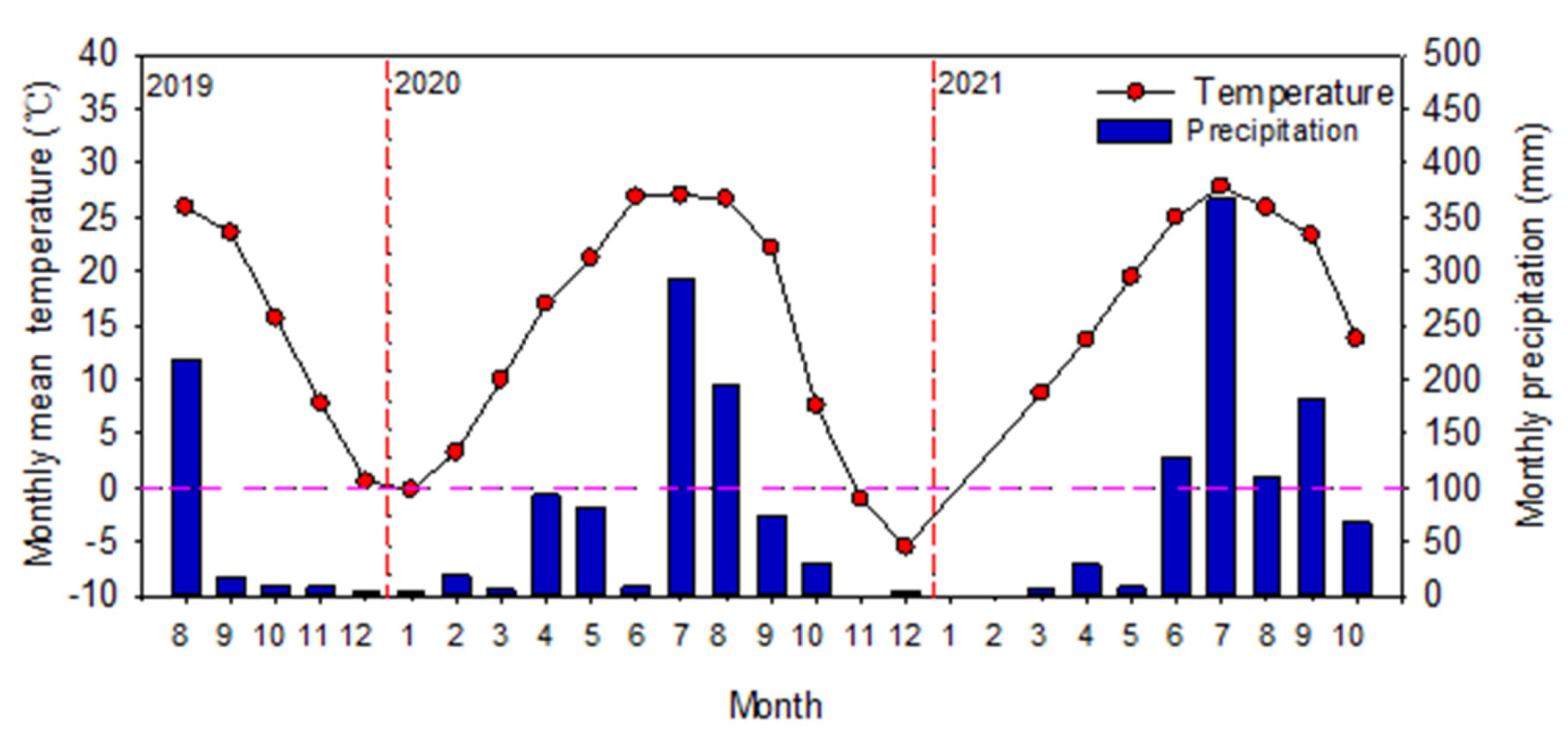
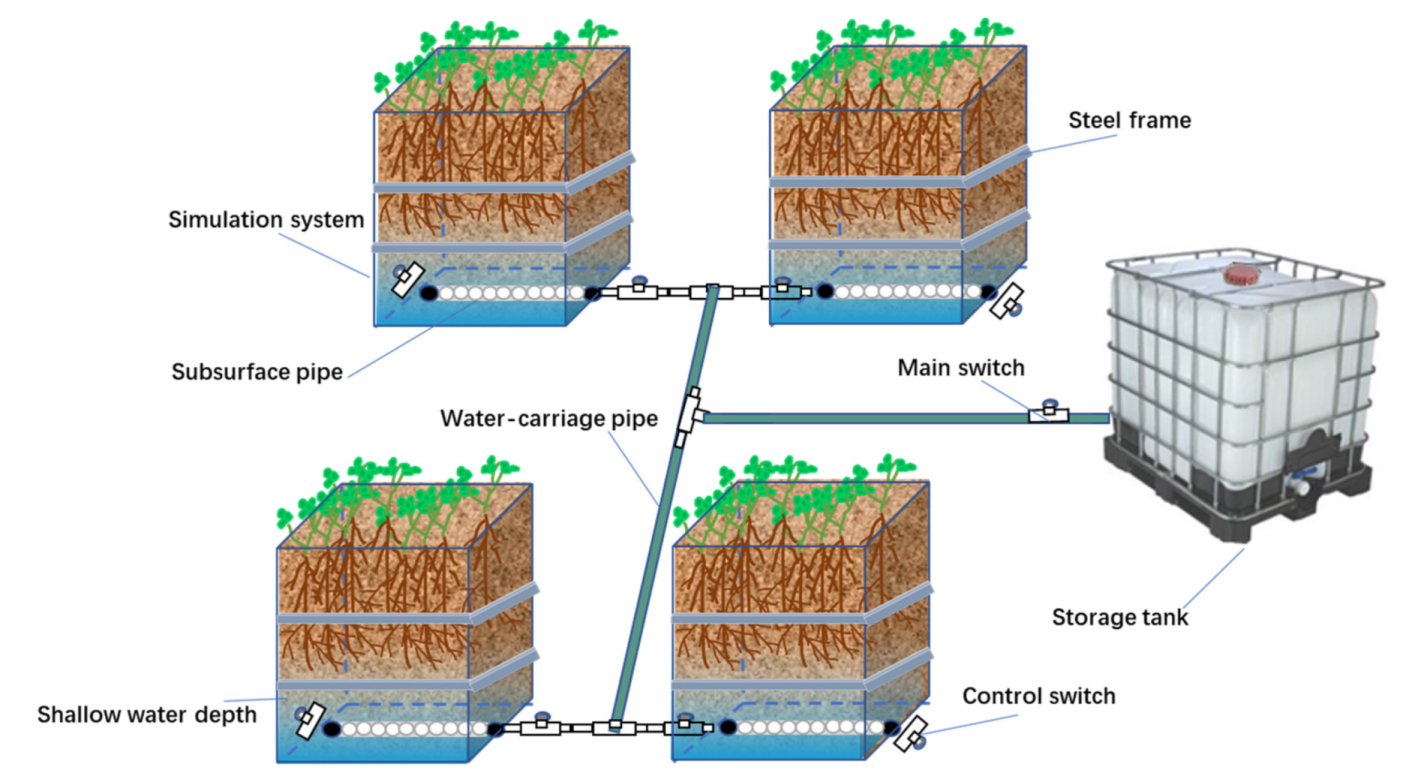
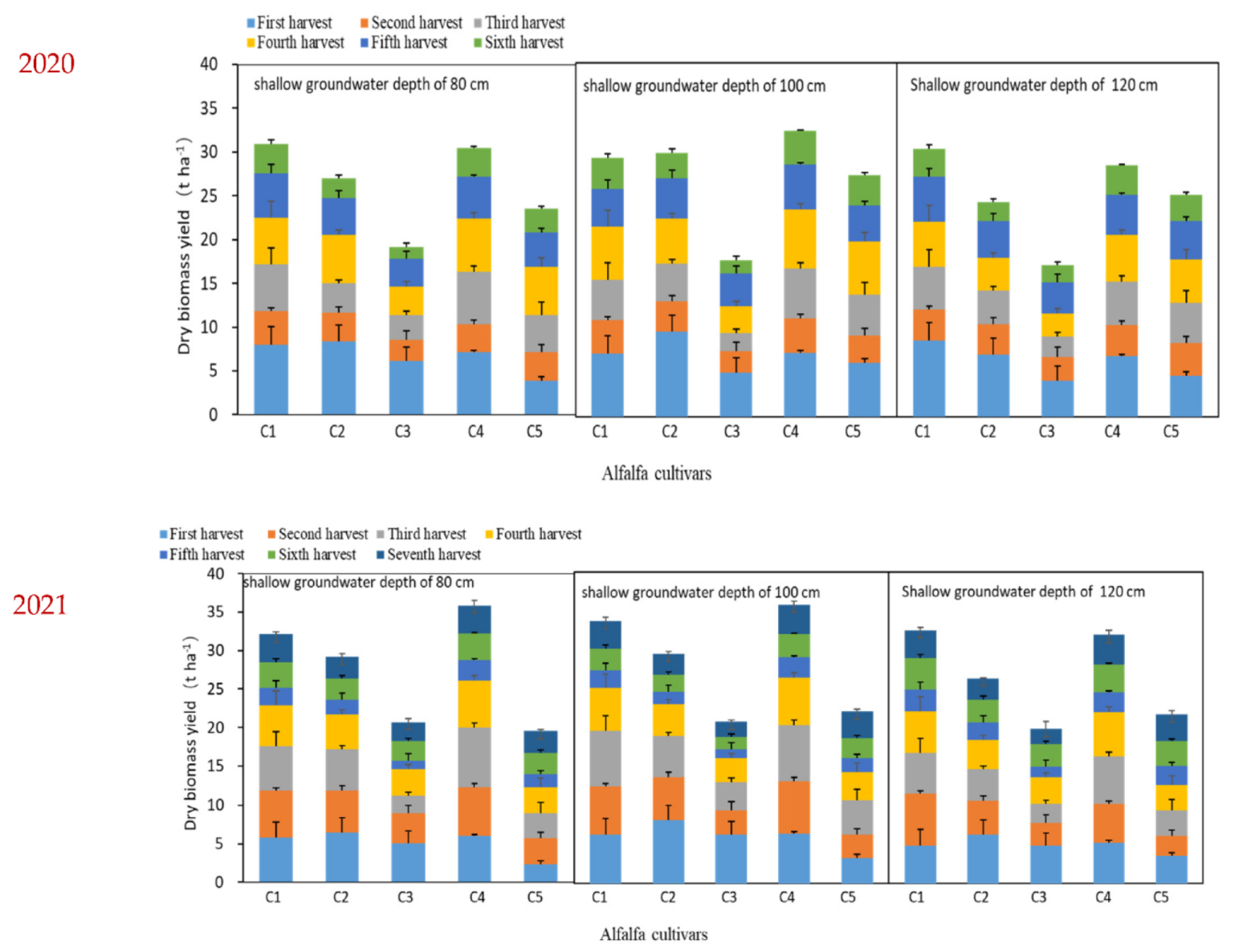

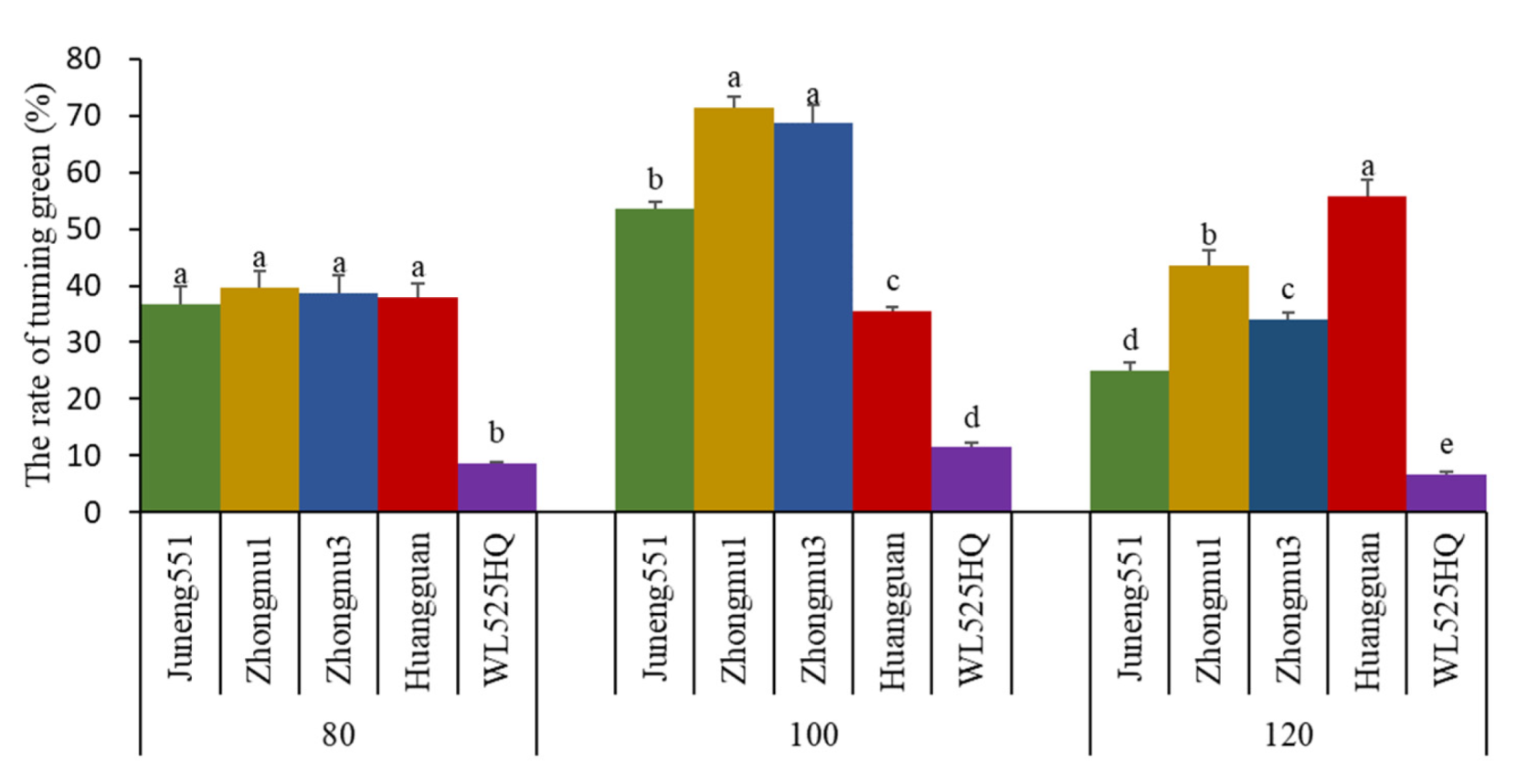
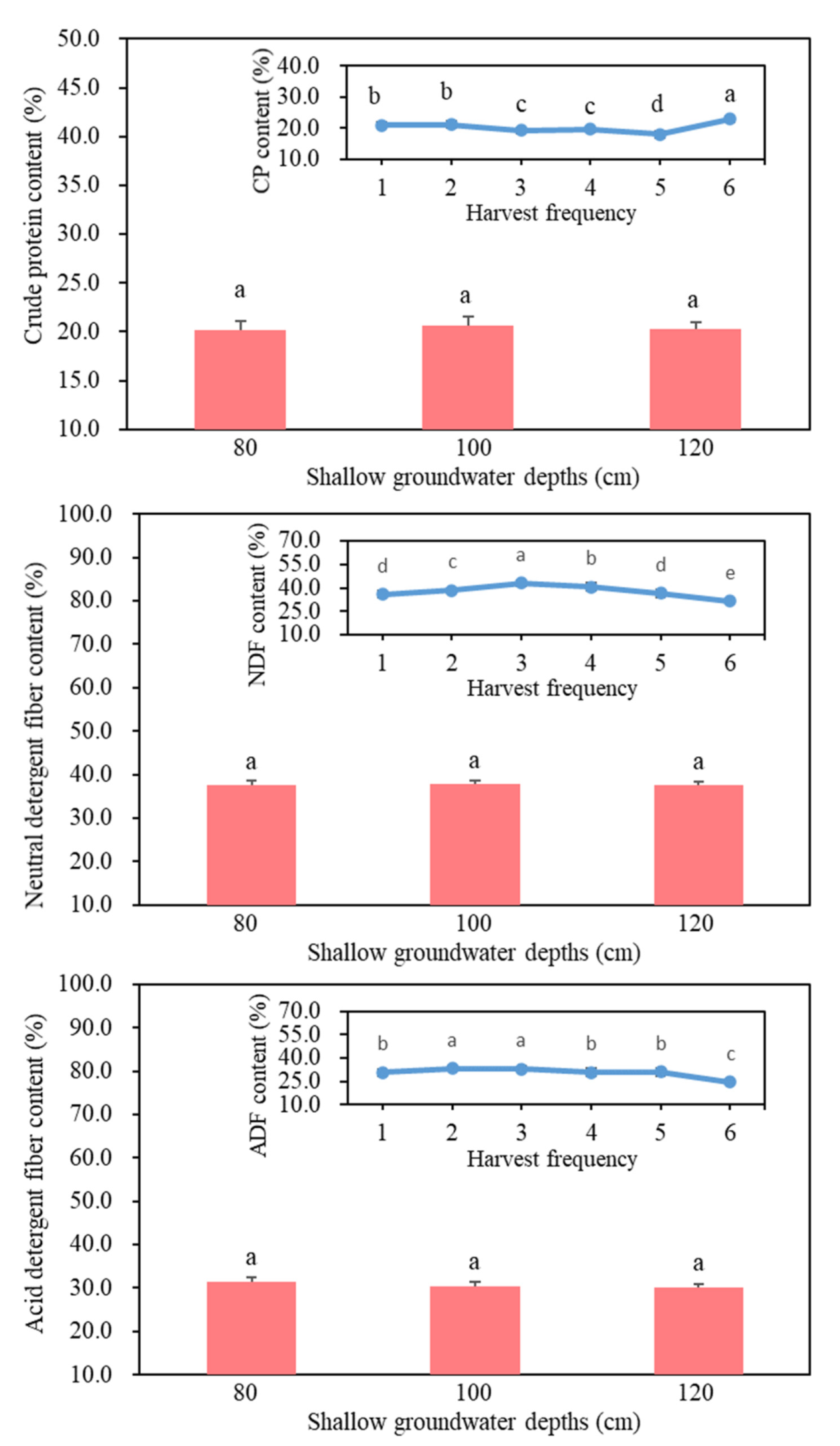
| Code | Cultivar’s Name | Fall Dormoncy Level | Seed Source |
|---|---|---|---|
| 1 | Magnum551 | 5.0 | Beijing Clover Seed Industry Co., Ltd. |
| 2 | Zhongmu No. 1 | 3.0 | Institute of Animal Science, CAAS |
| 3 | Zhongmu No. 3 | 3.0 | Institute of Animal Science, CAAS |
| 4 | Phabulous | 4.0 | Beijing Clover Seed Industry Co., Ltd. |
| 5 | WL525HQ | 8.0 | Beijing Rytway Ecotechnology Co., Ltd. |
| Factor | Annual Total Yield | CP | NDF | ADF | Turn-Green Ratio |
|---|---|---|---|---|---|
| Shallow groundwater depth (A) | 14.7 (0.9493) | 29.3 (0.0036 **) | 283.6 (<0.0001 ***) | 93.9 (<0.0001 ***) | 6.6 (0.9493) |
| Alfalfa cultivar (B) | 14.7 (<0.0001 ***) | 141.6 (<0.0001 ***) | 402.8 (<0.0001 ***) | 42.2 (<0.0001 ***) | 241.7 (<0.0001 ***) |
| A * B | 7.6 (<0.0001 ***) | 90.3 (<0.0001 ***) | 119.3 (<0.0001 ***) | 358.4 (<0.0001 ***) | 605.7 (<0.0001 ***) |
| Forage Yield of Each Harvest | Percent of Forage Yield in Each Harvest | ||||
| Shallow groundwater depth (A) | First harvest | 183.1 (<0.0001 ***) | 6.6 (0.9493) | ||
| Second harvest | 64.5 (<0.0001 ***) | 6.6 (0.9493) | |||
| Third harvest | 6.6 (0.9215) | 6.6 (0.9493) | |||
| Fourth harvest | 18.3 (0.1083) | 6.6 (0.9493) | |||
| Fifth harvest | 17.4 (0.0668) | 6.6 (0.9493) | |||
| Sixth harvest | 169.5 (<0.0001 ***) | 77.2 (<0.0001 ***) | |||
| Alfalfa cultivar (B) | First harvest | 179.0 (<0.0001 ***) | 277.2 (<0.0001 ***) | ||
| Second harvest | 5.4 (0.7118) | 157.3 (<0.0001 ***) | |||
| Third harvest | 461.5 (<0.0001 ***) | 167.9 (<0.0001 ***) | |||
| Fourth harvest | 1.1 (1.0000) | 167.9 (<0.0001 ***) | |||
| Fifth harvest | 40.2 (<0.0001 ***) | 232.4 (<0.0001 ***) | |||
| Sixth harvest | 27.4 (0.0023 **) | 12.7 (<0.0001 ***) | |||
| A * B | First harvest | 420.1 (<0.0001 ***) | 46.5 (<0.0001 ***) | ||
| Second harvest | 45.7 (<0.0001 ***) | 111.6 (<0.0001 ***) | |||
| Third harvest | 531.8 (<0.0001 ***) | 158.7 (<0.0001 ***) | |||
| Fourth harvest | 0.0 (1.0000) | 158.7 (<0.0001 ***) | |||
| Fifth harvest | 447.5 (<0.0001 ***) | 584.1 (<0.0001 ***) | |||
| Sixth harvest | 221.8 (<0.0001 ***) | 12.0 (1.0000) | |||
| Treatment | First Harvest | Second Harvest | Third Harvest | Fourth Harvest | Fifth Harvest | Sixth Harvest | Average | |
|---|---|---|---|---|---|---|---|---|
| Depths (cm) | Cultivars | |||||||
| 80 | Magnum551 | 2.07 ± 0.24 a | 2.08 ± 0.10 a | 1.92 ± 0.15 ab | 1.94 ± 0.10 a | 1.92 ± 0.11 a | 2.20 ± 0.07 a | 2.02 |
| Zhongmu No.1 | 2.03 ± 0.40 a | 2.06 ± 0.17 a | 1.96 ± 0.07 ab | 1.95 ± 0.07 a | 1.82 ± 0.06 ab | 2.36 ± 0.06 a | 2.03 | |
| Zhongmu No.3 | 2.00 ± 0.18 a | 2.11 ± 0.33 a | 2.03 ± 0.07 a | 1.91 ± 0.09 a | 1.89 ± 0.11 ab | 2.26 ± 0.15 a | 2.03 | |
| Phabulous | 2.12 ± 0.16 a | 2.09 ± 0.11 a | 1.92 ± 0.09 ab | 19.6 ± 0.8 a | 1.86 ± 0.11 ab | 2.32 ± 0.10 a | 2.04 | |
| WL525HQ | 2.02 ± 0.22 a | 1.95 ± 0.16 a | 1.84 ± 0.09 b | 1.85 ± 0.16 a | 1.74 ± 0.14 b | 2.28 ± 0.32 a | 1.95 | |
| Average | 2.05 B | 2.06 B | 1.93 C | 1.92 CD | 1.85 D | 2.28 A | ||
| 100 | Magnum551 | 2.02 ± 0.21 a | 2.15 ± 0.9 a | 1.98 ± 0.10 ab | 1.99 ± 0.05 ab | 1.88 ± 0.06 a | 2.31 ± 0.11 a | 2.06 |
| Zhongmu No.1 | 2.16 ± 0.14 a | 2.09 ± 0.17 a | 1.99 ± 0.10 ab | 1.94 ± 0.08 ab | 1.81 ± 0.16 a | 2.42 ± 0.07 a | 2.07 | |
| Zhongmu No.3 | 2.07 ± 0.16 a | 2.27 ± 0.17 a | 2.00 ± 0.17 a | 2.06 ± 0.07 a | 1.87 ± 0.13 a | 2.38 ± 0.16 a | 2.11 | |
| Phabulous | 2.17 ± 0.18 a | 2.07 ± 0.10 a | 2.03 ± 0.22 a | 2.07 ± 0.14 a | 1.91 ± 0.11 a | 2.32 ± 0.17 a | 2.10 | |
| WL525HQ | 2.00 ± 0.10 a | 2.03 ± 0.12 a | 1.80 ± 0.02 b | 1.85 ± 0.12 b | 1.82 ± 0.16 a | 2.28 ± 0.10 a | 1.96 | |
| Average | 2.08 B | 2.12 B | 1.96 C | 1.98 C | 1.86 D | 2.34 A | ||
| 120 | Magnum551 | 2.21 ± 0.17 a | 2.20 ± 0.14 a | 1.88 ± 0.18 a | 2.06 ± 0.09 a | 1.79 ± 0.13 a | 2.28 ± 0.04 a | 2.07 |
| Zhongmu No.1 | 1.96 ± 0.13 a | 2.25 ± 0.33 a | 1.94 ± 0.10 a | 1.96 ± 0.14 ab | 1.73 ± 0.12 a | 2.24 ± 0.06 ab | 2.01 | |
| Zhongmu No.3 | 2.25 ± 0.14 a | 2.31 ± 0.42 a | 1.97 ± 0.07 a | 2.03 ± 0.17 ab | 1.70 ± 0.10 a | 2.32 ± 0.08 a | 2.10 | |
| Phabulous | 2.24 ± 0.15 a | 2.09 ± 0.19 a | 1.87 ± 0.10 a | 2.01 ± 0.13 ab | 1.77 ± 0.16 a | 2.22 ± 0.05 ab | 2.03 | |
| WL525HQ | 2.17 ± 0.33 a | 2.02 ± 0.19 a | 1.84 ± 0.13 a | 1.86 ± 0.12 b | 1.53 ± 0.42 a | 2.17 ± 0.10 b | 1.93 | |
| Average | 2.17 A | 2.17 A | 1.91 B | 1.98 B | 1.70 C | 2.25 A | ||
| Treatment | First Harvest | Second Harvest | Third Harvest | Fourth Harvest | Fifth Harvest | Sixth Harvest | Average | |
|---|---|---|---|---|---|---|---|---|
| Depths (cm) | Cultivars | |||||||
| 80 | Magnum551 | 3.74 ± 0.81 a | 3.78 ± 0.16 a | 4.34 ± 0.30 a | 4.29 ± 0.28 a | 3.16 ± 0.42 a | 3.12 ± 0.23 a | 3.74 |
| Zhongmu No. 1 | 3.86 ± 0.56 a | 3.81 ± 0.31 a | 4.18 ± 0.42 a | 4.30 ± 0.30 a | 3.41 ± 0.55 a | 3.00 ± 0.58 a | 3.76 | |
| Zhongmu No. 3 | 3.92 ± 0.31 a | 3.84 ± 0.32 a | 4.17 ± 0.46 a | 3.89 ± 0.79 a | 3.38 ± 0.32 a | 3.11 ± 0.62 a | 3.72 | |
| Phabulous | 3.44 ± 0.31 a | 3.79 ± 0.28 a | 4.19 ± 0.27 a | 4.28 ± 0.33 a | 3.32 ± 0.47 a | 3.12 ± 0.17 a | 3.69 | |
| WL525 HQ | 3.39 ± 0.36 a | 4.13 ± 0.29 a | 4.41 ± 0.27 a | 4.35 ± 0.44 a | 3.71 ± 0.38 a | 3.16 ± 0.76 a | 3.86 | |
| 100 | Magnum551 | 3.58 ± 0.27 a | 3.78 ± 0.17 a | 3.90 ± 0.55 b | 3.99 ± 0.13 b | 3.75 ± 0.27 a | 3.05 ± 0.22 ab | 3.68 |
| Zhongmu No. 1 | 3.43 ± 0.44 a | 3.80 ± 0.43 a | 4.27 ± 0.24 ab | 4.15 ± 0.13 ab | 3.84 ± 0.27 a | 3.11 ± 0.49 ab | 3.77 | |
| Zhongmu No. 3 | 3.78 ± 0.31 a | 3.68 ± 0.38 a | 4.39 ± 0.39 ab | 3.97 ± 0.27 b | 3.70 ± 0.23 a | 2.94 ± 0.22 ab | 3.74 | |
| Phabulous | 3.52 ± 0.22 a | 3.78 ± 0.19 a | 3.99 ± 0.41 ab | 3.84 ± 0.21 b | 3.89 ± 0.13 a | 2.86 ± 0.42 b | 3.65 | |
| WL525 HQ | 3.64 ± 0.12 a | 4.07 ± 0.35 a | 4.55 ± 0.32 a | 4.38 ± 0.33 a | 4.05 ± 0.34 a | 3.39 ± 0.21 a | 4.01 | |
| 120 | Magnum551 | 3.26 ± 0.18 a | 3.67 ± 0.21 a | 4.38 ± 0.16 a | 3.66 ± 0.45 b | 3.59 ± 0.21 a | 3.24 ± 0.42 a | 3.63 |
| Zhongmu No. 1 | 3.89 ± 0.28 a | 3.97 ± 0.31 a | 4.34 ± 0.46 a | 3.82 ± 0.28 ab | 4.00 ± 0.33 a | 3.23 ± 0.55 a | 3.88 | |
| Zhongmu No. 3 | 3.51 ± 0.44 a | 3.63 ± 0.68 a | 4.41 ± 0.22 a | 3.84 ± 0.31 ab | 3.65 ± 0.39 a | 3.23 ± 0.31 a | 3.71 | |
| Phabulous | 3.38 ± 0.27 a | 3.67 ± 0.27 a | 4.50 ± 0.31 a | 3.64 ± 0.15 b | 3.44 ± 0.52 a | 3.20 ± 0.18 a | 3.64 | |
| WL525 HQ | 3.33 ± 0.50 a | 3.96 ± 0.59 a | 4.51 ± 0.42 a | 4.24 ± 0.36 a | 3.79 ± 0.62 a | 3.44 ± 0.18 a | 3.88 | |
| Treatment | First Harvest | Second Harvest | Third Harvest | Fourth Harvest | Fifth Harvest | Sixth Harvest | Average | |
|---|---|---|---|---|---|---|---|---|
| Depths (cm) | Cultivars | |||||||
| 80 | Magnum551 | 3.08 ± 0.35 a | 3.32 ± 0.11 a | 3.20 ± 0.54 a | 3.24 ± 0.18 ab | 3.37 ± 0.33 a | 2.47 ± 0.44 b | 3.11 |
| Zhongmu No. 1 | 3.20 ± 0.33 a | 3.21 ± 0.20 a | 3.19 ± 0.15 a | 3.09 ± 0.29 ab | 3.39 ± 0.50 a | 2.45 ± 0.15 ab | 3.09 | |
| Zhongmu No. 3 | 3.41 ± 0.39 a | 3.34 ± 0.31 a | 3.29 ± 0.44 a | 2.99 ± 0.49 b | 3.29 ± 0.32 a | 2.49 ± 0.44 b | 3.14 | |
| Phabulous | 2.96 ± 0.29 a | 3.37 ± 0.27 a | 3.21 ± 0.19 a | 3.26 ± 0.29 ab | 3.37 ± 0.25 a | 2.52 ± 0.20 b | 3.12 | |
| WL525 HQ | 2.93 ± 0.39 a | 3.51 ± 0.14 a | 3.51 ± 0.21 a | 3.57 ± 0.46 a | 3.45 ± 0.45 a | 2.64 ± 0.55 a | 3.27 | |
| 100 | Magnum551 | 3.14 ± 0.25 a | 3.31 ± 0.17 a | 3.24 ± 0.23 ab | 3.01 ± 0.13 b | 2.98 ± 0.22 b | 2.45 ± 0.26 ab | 3.02 |
| Zhongmu No. 1 | 3.01 ± 0.45 a | 3.16 ± 0.04 a | 3.16 ± 0.34 ab | 3.06 ± 0.28 b | 3.07 ± 0.13 ab | 2.30 ± 0.15 b | 2.96 | |
| Zhongmu No. 3 | 3.32 ± 0.31 a | 3.24 ± 0.35 a | 3.42 ± 0.52 ab | 2.80 ± 0.18 b | 2.96 ± 0.20 b | 2.23 ± 0.20 b | 3.00 | |
| Phabulous | 3.06 ± 0.22 a | 3.33 ± 0.22 a | 3.02 ± 0.38 b | 2.85 ± 0.28 b | 2.98 ± 0.25 b | 2.31 ± 0.33 b | 2.93 | |
| WL525 HQ | 3.17 ± 0.11 a | 3.50 ± 0.10 a | 3.61 ± 0.19 a | 3.45 ± 0.28 a | 3.33 ± 0.30 a | 2.71 ± 0.04 a | 3.30 | |
| 120 | Magnum551 | 2.85 ± 0.20 a | 3.24 ± 0.20 a | 3.37 ± 0.33 a | 2.83 ± 0.33 b | 2.72 ± 0.30 a | 2.41 ± 0.25 b | 2.90 |
| Zhongmu No. 1 | 3.38 ± 0.29 a | 3.41 ± 0.27 a | 3.39 ± 0.50 a | 2.97 ± 0.28 ab | 3.13 ± 0.42 a | 2.47 ± 0.12 b | 3.13 | |
| Zhongmu No. 3 | 3.06 ± 0.42 a | 3.20 ± 0.66 a | 3.29 ± 0.32 a | 3.00 ± 0.28 ab | 2.83 ± 0.29 a | 2.52 ± 0.14 b | 2.98 | |
| Phabulous | 2.96 ± 0.21 a | 3.30 ± 0.25 a | 3.37 ± 0.25 a | 2.77 ± 0.16 b | 2.79 ± 0.40 a | 2.47 ± 0.16 b | 2.95 | |
| WL525 HQ | 2.89 ± 0.49 a | 3.47 ± 0.53 a | 3.45 ± 0.45 a | 3.33 ± 0.29 a | 3.04 ± 0.14 a | 2.81 ± 0.08 a | 3.17 | |
Publisher’s Note: MDPI stays neutral with regard to jurisdictional claims in published maps and institutional affiliations. |
© 2022 by the authors. Licensee MDPI, Basel, Switzerland. This article is an open access article distributed under the terms and conditions of the Creative Commons Attribution (CC BY) license (https://creativecommons.org/licenses/by/4.0/).
Share and Cite
Wang, S.; Guo, K.; Ameen, A.; Fang, D.; Li, X.; Liu, X.; Han, L. Evaluation of Different Shallow Groundwater Tables and Alfalfa Cultivars for Forage Yield and Nutritional Value in Coastal Saline Soil of North China. Life 2022, 12, 217. https://doi.org/10.3390/life12020217
Wang S, Guo K, Ameen A, Fang D, Li X, Liu X, Han L. Evaluation of Different Shallow Groundwater Tables and Alfalfa Cultivars for Forage Yield and Nutritional Value in Coastal Saline Soil of North China. Life. 2022; 12(2):217. https://doi.org/10.3390/life12020217
Chicago/Turabian StyleWang, Shichao, Kai Guo, Asif Ameen, Dong Fang, Xiaolin Li, Xiaojing Liu, and Lipu Han. 2022. "Evaluation of Different Shallow Groundwater Tables and Alfalfa Cultivars for Forage Yield and Nutritional Value in Coastal Saline Soil of North China" Life 12, no. 2: 217. https://doi.org/10.3390/life12020217
APA StyleWang, S., Guo, K., Ameen, A., Fang, D., Li, X., Liu, X., & Han, L. (2022). Evaluation of Different Shallow Groundwater Tables and Alfalfa Cultivars for Forage Yield and Nutritional Value in Coastal Saline Soil of North China. Life, 12(2), 217. https://doi.org/10.3390/life12020217






